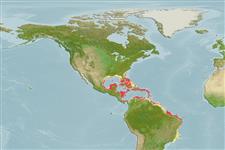Common names from other countries
Environment: milieu / climate zone / depth range / distribution range
Ecologia
marinhas associadas(os) a recifes; intervalo de profundidade 20 - 60 m (Ref. 5217). Tropical; 33°N - 33°S, 99°W - 30°W
Western Atlantic: Florida Keys (USA), Bermuda, and Bahamas to Brazil. Found throughout the West Indies; absent in Colombia (Ref. 3798).
Length at first maturity / Tamanho / Peso / Idade
Maturity: Lm 30.5, range 30 - ? cm
Max length : 79.0 cm TL macho/indeterminado; (Ref. 40637); common length : 50.0 cm TL macho/indeterminado; (Ref. 5217); peso máx. Publicado: 7.1 kg (Ref. 40637)
Espinhos dorsais (total) : 12; Raios dorsais moles (total) : 15 - 17; Espinhos anais: 3; Raios anais moles: 7 - 8. Scale rows immediately below lateral line oblique (Ref. 26938). Usual color phase dull silvery, the fins largely gray; no black pigment below upper margin of preopercle; the dorsal and caudal fins of subadults and the back above a line from dorsal base to lower margin of caudal fin are often blackish (Ref. 13442).
Inhabits seagrass beds, sand flats, coral reefs, and wrecks (Ref. 9710). Found in pairs or larger schools (Ref. 3798). Feeds on benthic invertebrates (Ref. 3798). Has been observed to nose into the sand to eat such subsurface invertebrates as peanut worms and heart urchins (Ref. 13442). Marketed fresh (Ref. 3798).
Oviparous, distinct pairing during breeding (Ref. 205).
Cervigón, F., 1993. Los peces marinos de Venezuela. Volume 2. Fundación Científica Los Roques, Caracas,Venezuela. 497 p. (Ref. 9626)
Categoria na Lista Vermelha da IUCN (Ref. 130435)
CITES (Ref. 128078)
Not Evaluated
Ameaça para o homem
Reports of ciguatera poisoning (Ref. 30303)
Utilização humana
Pescarias: espécies comerciais; peixe desportivo: sim; Aquário: Aquários públicos
Ferramentas
Relatórios especiais
Descarregue XML
Fontes da internet
Estimates based on models
Preferred temperature (Ref.
115969): 21.1 - 27.6, mean 25 (based on 110 cells).
Phylogenetic diversity index (Ref.
82804): PD
50 = 0.5000 [Uniqueness, from 0.5 = low to 2.0 = high].
Bayesian length-weight: a=0.01202 (0.00775 - 0.01866), b=3.00 (2.87 - 3.13), in cm Total Length, based on LWR estimates for this species & Genus-body shape (Ref.
93245).
Nível Trófico (Ref.
69278): 3.3 ±0.1 se; based on diet studies.
Resiliência (Ref.
120179): Médio, tempo mínimo de duplicação da população 1,4 - 4,4 anos (K=0.19-0.20; tm=3.5; Fec=800,000).
Fishing Vulnerability (Ref.
59153): Moderate vulnerability (45 of 100).
